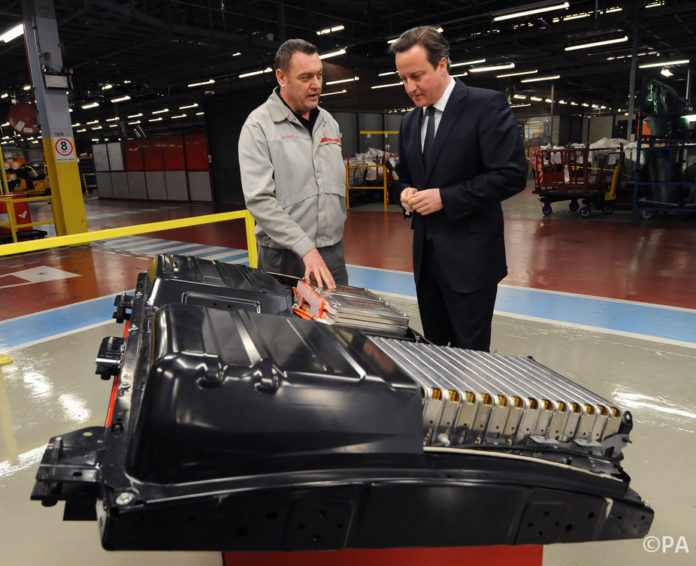
By Richard Brooks, Coventry University
British-owned car manufacturing has been in decline in UK for decades but the shift to electric cars might be just what is needed for a revival. The recent announcement by US-based Detroit Electric that it will move its production to the UK highlights some of the engineering strengths Britain possesses – but will local entrepreneurs see it too?
Britain might be a minor player in the emerging hybrid and pure electric vehicle (EV) market, but it was not always so. Indeed, the UK has a credible claim to have invented both the electric locomotive carriage in the 1830s, and the electric car in the 1880s. By the late 1880 and 1890s, the UK and France were leading the world in the deployment of the vehicles, with an electric taxi firm operating on London streets by the turn of the 20th century.

Science Museum
Sadly its time was not to be and during most of the 20th century, the internal combustion engine made greater advances in price, range and performance; electric vehicles were pushed into niche markets such as indoor moving equipment or milk deliveries.
The decline in British industry throughout the 1960s, 1970s and 1980s meant EV firms lacked access to both the most recent technology and domestic car-makers who might operate as partners and clients. One of the reasons why Japan played such a prominent early role is that advances made in industries such as consumer electronics could be transferred across to automotive mass-production – sometimes within the same group of companies.
The Tesla moment
Yet, to say Britain can’t compete because it lacks a “domestic champion” car-maker would be letting its would-be innovators off too lightly. Tesla Motors succeeded precisely because it wasn’t a large car maker, but a small company with a big idea that was willing to take the risks it’s bigger rivals wouldn’t.
In 2008, many automotive multi-nationals were sceptical of EV technology and the electric cars they developed were typically less reliable and lower powered than their petrol and diesel equivalents. Tesla upturned expectations by aiming squarely at cash-rich early adopters.

Lewis Whyld/PA
It was an audacious pitch and Elon Musk, internet tycoon turned Tesla founder, was not an experienced car-maker. He therefore turned towards the British firm Lotus Cars to provide the “glider” or body of the car. In this move Californian money and technology was married with British design and production to provide an eye-catching, prestige vehicle that was also sufficiently lightweight to suit the lower weigh-to-power ratio of EVs.
The Tesla strategy
Given Tesla’s success it is not surprising that others such as Albert Lam, a former Lotus executive, emulated its strategy. Lam first moved into the EV market by reviving the Detroit Electric brand – a firm that had been one of the pioneers of electric vehicles in the early 1900s, before ceasing production in 1939.

Infrogmation
Today its flagship SP.01, marketed as “the fastest EV on the market” also makes use of a Lotus designed body but goes a step further than Tesla by basing its European factory in Royal Leamington Spa, West Midlands. Lam himself is no stranger to the area: he has a degree from Coventry University and has held positions in local car-makers Jaguar and Land Rover. No doubt he is aware of the region’s association with low-volume prestige brands, its excellent supply base, world-leading motorsports expertise and strong R&D facilities focused on low-carbon vehicles.
Indeed, the British car industry looks attractive for overseas investors in general. Nissan’s decision to assemble the market-leading Leaf in its Sunderland plant makes sense: the UK has high-levels of productivity in the sector (second only to Germany in Europe), favourable corporate tax levels, a package of government incentives for electric vehicle consumers and a buoyant car market. In short, the country has a lot to offer EV manufacturers.
Why are British firms having problems?
This being the case it’s worth asking why it has taken an American company to recognise the value of these assets. Mostly it comes to down to technology, money and perhaps some entrepreneurial caution.
The UK has its strengths but there are notable gaps to make the transition to EV. Industry analyst Peter Harrop of IDTechEx notes that the UK is “world-class in terms of innovative component suppliers” but “nowhere” in terms of electric car batteries.
Another big problem is the availability of cash (or even credit) to fund a jump into electric. Britain’s small band of domestic car makers tend to operate on a relatively small scale and often struggle to finance their existing lines. Coventry University Entreprise’s research into suppliers found that without big clients emergent EV technology firms lack partners to take prototypes into production and often shift into engineering consultancy rather than manufacturing.
It’s about networks
Detroit Electric’s move into the UK could certainly catalyse the industry. It would provide a client for component suppliers looking to move into a new field; a partner for training academies to develop a new generation of engineers – and, most importantly, it represents a model for other entrepreneurs to follow.
Albert Lam is not a tycoon in the style of Elon Musk, but a businessman who has spotted an opportunity and brought together a classic brand, US technology, British production and access to the North American and European markets in an endeavour that is likely to capture people’s attention, at the very least. Succeed or fail, the lesson for British entrepreneurs is clear: make use of the assets you’ve got, but think global. The window for innovations in the electric vehicle market is still open but it may not be for too long.
![]()
Richard Brooks receives funding from the EC to participate in the FP7 project INTRASME looking at electric vehicle supply chains. The opinions expressed within this article are in no way influenced by any constraints imposed by the funding.
This article was originally published on The Conversation.
Read the original article.


















